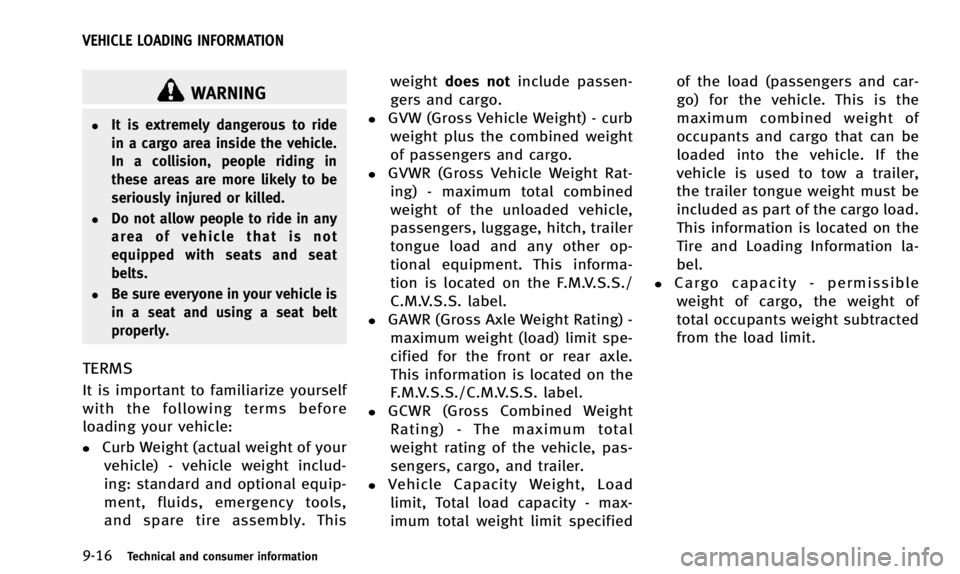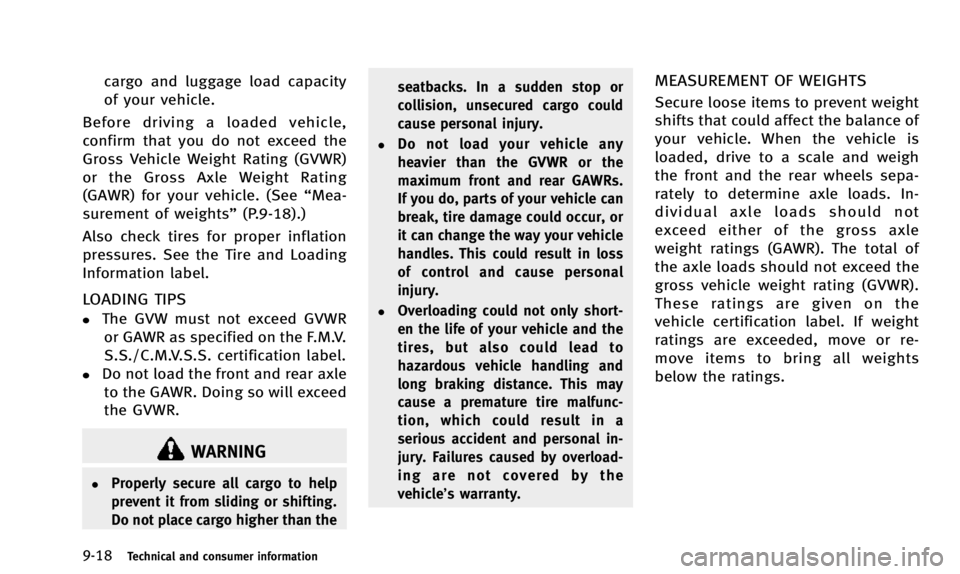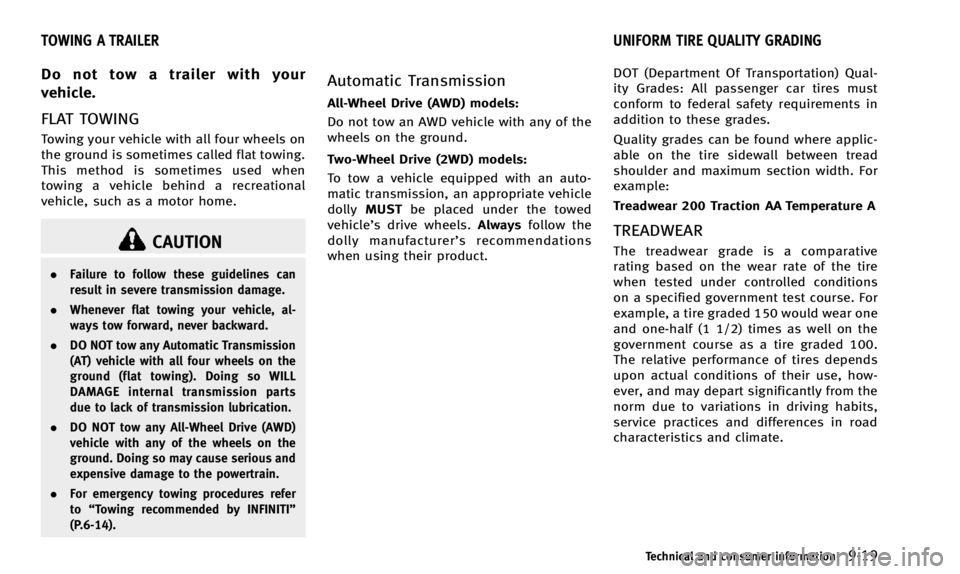INFINITI Q50 2014 Owner's Manual
Manufacturer: INFINITI, Model Year: 2014, Model line: Q50, Model: INFINITI Q50 2014Pages: 394, PDF Size: 1.99 MB
Page 371 of 394

9-12Technical and consumer information
STI0509
ENGINE SERIAL NUMBER
The number is stamped on the engine as
shown.
STI0718
F.M.V.S.S./C.M.V.S.S. CERTIFICA-
TION LABEL
The Federal/Canadian Motor Vehicle Safety
Standards (F.M.V.S.S./C.M.V.S.S.) certifica-
tion label is affixed as shown. This label
contains valuable vehicle information, such
as: Gross Vehicle Weight Ratings (GVWR),
Gross Axle Weight Rating (GAWR), month
and year of manufacture, Vehicle Identifi-
cation Number (VIN), etc. Review it care-
fully.
STI0719
EMISSION CONTROL INFORMATION
LABEL
The emission control information label is
attached as shown.
Page 372 of 394

JVT0220X
TIRE AND LOADING INFORMATION
LABEL
The cold tire pressure is shown on the Tire
and Loading Information label affixed to
the pillar as illustrated.
STI0721
AIR CONDITIONER SPECIFICATION
LABEL
The air conditioner specification label is
attached as shown.
Technical and consumer information9-13
Page 373 of 394

9-14Technical and consumer information
JVT0222X
Use the following steps to mount the
license plate:
Before mounting the license plate, confirm
that the following parts are enclosed in the
plastic bag.
Only use the recommended mounting
position, otherwise the radar sensor (In-
telligent Cruise Control (ICC) system) (if so
equipped) obstruction may result.
.License plate bracket
. J-nut 62
. Screw 62
. Screw grommet 62
1. Park the vehicle on flat, level ground.
2. Locate the center position
*Aas
illustrated. Position the license plate
bracket at a distance of approximately
1.26 in (32 mm)
*Bfrom the bottom of
the bumper. Hold the license plate
bracket in place.
3. Mark the center of the hole
*Cwith a
felt-tip pen.
4. Carefully drill two pilot holes using a 0.35 in (9 mm) drill bit at the marked
locations. (Be sure that the drill only
goes through the bumper fascia.)
INSTALLING FRONT LICENSE PLATE
Page 374 of 394

5. Insert grommets into the hole on thefascia.
6. Insert a flat-blade screwdriver into the grommet hole to add 908 turn onto the
part
*D.
7. Install the license plate bracket with screws.
STI0623
Left side
This vehicle is equipped with air deflectors
in front of the front wheels. The deflectors
will change the air flow to help improve
aerodynamic performance.
When transporting your vehicle on a trailer,
the air deflectors may interfere with a
steep slope to a trailer bed. In this case,
remove the deflectors from the undercover
of the vehicle.
1. Loosen three screws as shown and
remove the left-side air deflector
*A.
2. Tighten the removed screw
*Bin its
original position. 3. Perform the same procedure to remove
the right-side air deflector.
4. Store the two air deflectors and four screws to reinstall in the reverse order.
5. When reinstalling, make sure all six screws are firmly tightened on both air
deflectors.
Technical and consumer information9-15
REMOVING AIR DEFLECTORS
Page 375 of 394

9-16Technical and consumer information
WARNING
.It is extremely dangerous to ride
in a cargo area inside the vehicle.
In a collision, people riding in
these areas are more likely to be
seriously injured or killed.
.Do not allow people to ride in any
area of vehicle that is not
equipped with seats and seat
belts.
.Be sure everyone in your vehicle is
in a seat and using a seat belt
properly.
TERMS
It is important to familiarize yourself
with the following terms before
loading your vehicle:
.Curb Weight (actual weight of yourvehicle) - vehicle weight includ-
ing: standard and optional equip-
ment, fluids, emergency tools,
and spare tire assembly. This weight
does not include passen-
gers and cargo.
.GVW (Gross Vehicle Weight) - curb weight plus the combined weight
of passengers and cargo.
.GVWR (Gross Vehicle Weight Rat-ing) - maximum total combined
weight of the unloaded vehicle,
passengers, luggage, hitch, trailer
tongue load and any other op-
tional equipment. This informa-
tion is located on the F.M.V.S.S./
C.M.V.S.S. label.
.GAWR (Gross Axle Weight Rating) -maximum weight (load) limit spe-
cified for the front or rear axle.
This information is located on the
F.M.V.S.S./C.M.V.S.S. label.
.GCWR (Gross Combined WeightRating) - The maximum total
weight rating of the vehicle, pas-
sengers, cargo, and trailer.
.Vehicle Capacity Weight, Loadlimit, Total load capacity - max-
imum total weight limit specified of the load (passengers and car-
go) for the vehicle. This is the
maximum combined weight of
occupants and cargo that can be
loaded into the vehicle. If the
vehicle is used to tow a trailer,
the trailer tongue weight must be
included as part of the cargo load.
This information is located on the
Tire and Loading Information la-
bel.
.Cargo capacity - permissible
weight of cargo, the weight of
total occupants weight subtracted
from the load limit.
VEHICLE LOADING INFORMATION
Page 376 of 394

STI0365
VEHICLE LOAD CAPACITY
Do not exceed the load limit of your
vehicle shown as“The combined
weight of occupants and cargo” on
the Tire and Loading Information
label. Do not exceed the number of
occupants shown as “Seating Capa-
city” on the Tire and Loading In-
formation label.
To get “the combined weight of
occupants and cargo” , add the
weight of all occupants, then add the total luggage weight. Examples
are shown in the illustration.
Steps for determining correct load
limit
1.Locate the statement
“The com-
bined weight of occupants and
cargo should never exceed XXX kg
or XXX lbs” on your vehicle’ s
placard.
2.Determine the combined weight of
the driver and passengers that
will be riding in your vehicle.
3.Subtract the combined weight of
the driver and passengers from
XXX kg or XXX lbs.
4.The resulting figure equals the
available amount of cargo and
luggage load capacity. For exam-
ple, if the XXX amount equals
1400 lbs. and there will be five
150 lb. passengers in your vehi-
cle, the amount of available cargo
and luggage load capacity is 650
lbs. (1400 −750 (5 x 150) = 650
lbs or 640 −340 (5 x 70) = 300
kg.)
5.Determine the combined weight of
luggage and cargo being loaded
on the vehicle. That weight may
not safely exceed the available
cargo and luggage load capacity
calculated in Step 4.
6.If your vehicle will be towing a
trailer, load from your trailer will
be transferred to your vehicle.
Consult this manual to determine
how this reduces the available
Technical and consumer information9-17
Page 377 of 394

9-18Technical and consumer information
cargo and luggage load capacity
of your vehicle.
Before driving a loaded vehicle,
confirm that you do not exceed the
Gross Vehicle Weight Rating (GVWR)
or the Gross Axle Weight Rating
(GAWR) for your vehicle. (See “Mea-
surement of weights” (P.9-18).)
Also check tires for proper inflation
pressures. See the Tire and Loading
Information label.
LOADING TIPS
.The GVW must not exceed GVWR or GAWR as specified on the F.M.V.
S.S./C.M.V.S.S. certification label.
.Do not load the front and rear axle
to the GAWR. Doing so will exceed
the GVWR.
WARNING
.Properly secure all cargo to help
prevent it from sliding or shifting.
Do not place cargo higher than the seatbacks. In a sudden stop or
collision, unsecured cargo could
cause personal injury.
.Do not load your vehicle any
heavier than the GVWR or the
maximum front and rear GAWRs.
If you do, parts of your vehicle can
break, tire damage could occur, or
it can change the way your vehicle
handles. This could result in loss
of control and cause personal
injury.
.Overloading could not only short-
en the life of your vehicle and the
tires, but also could lead to
hazardous vehicle handling and
long braking distance. This may
cause a premature tire malfunc-
tion, which could result in a
serious accident and personal in-
jury. Failures caused by overload-
ing are not covered by the
vehicle’s warranty.
MEASUREMENT OF WEIGHTS
Secure loose items to prevent weight
shifts that could affect the balance of
your vehicle. When the vehicle is
loaded, drive to a scale and weigh
the front and the rear wheels sepa-
rately to determine axle loads. In-
dividual axle loads should not
exceed either of the gross axle
weight ratings (GAWR). The total of
the axle loads should not exceed the
gross vehicle weight rating (GVWR).
These ratings are given on the
vehicle certification label. If weight
ratings are exceeded, move or re-
move items to bring all weights
below the ratings.
Page 378 of 394

Do not tow a trailer with your
vehicle.
FLAT TOWING
Towing your vehicle with all four wheels on
the ground is sometimes called flat towing.
This method is sometimes used when
towing a vehicle behind a recreational
vehicle, such as a motor home.
CAUTION
.Failure to follow these guidelines can
result in severe transmission damage.
. Whenever flat towing your vehicle, al-
ways tow forward, never backward.
. DO NOT tow any Automatic Transmission
(AT) vehicle with all four wheels on the
ground (flat towing). Doing so WILL
DAMAGE internal transmission parts
due to lack of transmission lubrication.
. DO NOT tow any All-Wheel Drive (AWD)
vehicle with any of the wheels on the
ground. Doing so may cause serious and
expensive damage to the powertrain.
. For emergency towing procedures refer
to“Towing recommended by INFINITI”
(P.6-14).
Automatic Transmission
All-Wheel Drive (AWD) models:
Do not tow an AWD vehicle with any of the
wheels on the ground.
Two-Wheel Drive (2WD) models:
To tow a vehicle equipped with an auto-
matic transmission, an appropriate vehicle
dolly MUST be placed under the towed
vehicle’s drive wheels. Alwaysfollow the
dolly manufacturer’ s recommendations
when using their product. DOT (Department Of Transportation) Qual-
ity Grades: All passenger car tires must
conform to federal safety requirements in
addition to these grades.
Quality grades can be found where applic-
able on the tire sidewall between tread
shoulder and maximum section width. For
example:
Treadwear 200 Traction AA Temperature A
TREADWEAR
The treadwear grade is a comparative
rating based on the wear rate of the tire
when tested under controlled conditions
on a specified government test course. For
example, a tire graded 150 would wear one
and one-half (1 1/2) times as well on the
government course as a tire graded 100.
The relative performance of tires depends
upon actual conditions of their use, how-
ever, and may depart significantly from the
norm due to variations in driving habits,
service practices and differences in road
characteristics and climate.
Technical and consumer information9-19
TOWING A TRAILER
UNIFORM TIRE QUALITY GRADING
Page 379 of 394

9-20Technical and consumer information
TRACTION AA, A, B AND C
The traction grades, from highest to low-
est, are AA, A, B and C. Those grades
represent the tire’s ability to stop on wet
pavement as measured under controlled
conditions on specified government test
surfaces of asphalt and concrete. A tire
marked C may have poor traction perfor-
mance.
WARNING
The traction grade assigned to this tire is
based on straight-ahead braking traction
tests, and does not include acceleration,
cornering, hydroplaning, or peak traction
characteristics.
TEMPERATURE A, B AND C
The temperature grades A (the highest), B,
and C, representing the tire’s resistance to
the generation of heat and its ability to
dissipate heat when tested under con-
trolled conditions on a specified indoor
laboratory test wheel. Sustained high
temperature can cause the material of the
tire to degenerate and reduce tire life, and
excessive temperature can lead to suddentire failure. The grade C corresponds to a
level of performance which all passenger
car tires must meet under the Federal
Motor Vehicle Safety Standard No. 109.
Grades B and A represent higher levels of
performance on the laboratory test wheel
than the minimum required by law.
WARNING
The temperature grade for this tire is
established for a tire that is properly
inflated and not overloaded. Excessive
speed, under-inflation, or excessive loading,
either separately or in combination, can
cause heat build-up and possible tire failure.
Your INFINITI is covered by the following
emission warranties.
For USA:
.
Emission Defects Warranty
. Emissions Performance Warranty
Details of these warranties may be found
with other vehicle warranties in your
Warranty Information Booklet that comes
with your INFINITI. If you did not receive a
Warranty Information Booklet, or it has
become lost, you may obtain a replace-
ment by writing to:
. INFINITI Division
Nissan North America, Inc.
Consumer Affairs Department
P.O. Box 685003
Franklin, TN 37068-5003
EMISSION CONTROL SYSTEM WARRANTY
Page 380 of 394

For Canada:
Emission Control System Warranty
Details of these warranties may be found
with other vehicle warranties in your
Warranty and Roadside Assistance Infor-
mation that comes with your INFINITI. If you
did not receive a Warranty and Roadside
Assistance Information, or it has become
lost, you may obtain a replacement by
writing to:
.Nissan Canada Inc.
5290 Orbitor Drive
Mississauga, Ontario,
L4W 4Z5For USA
If you believe that your vehicle has a
defect which could cause a crash or
could cause injury or death, you
should immediately inform the Na-
tional Highway Traffic Safety Admin-
istration (NHTSA) in addition to
notifying INFINITI.
If NHTSA receives similar complaints,
it may open an investigation, and if it
finds that a safety defect exists in a
group of vehicles, it may order a
recall and remedy campaign. How-
ever, NHTSA cannot become involved
in individual problems between you,
your retailer, or INFINITI.
To contact NHTSA, you may call the
Vehicle Safety Hotline toll-free at 1-
888-327-4236 (TTY: 1-800-424-
9153); go to http://www.safercar.
gov; or write to: Administrator,
NHTSA, 400 Seventh Street, SW.,
Washington DC 20590. You can also
obtain other information about motor
vehicle safety from http://www.safe- rcar. gov.
You may notify INFINITI by contacting
our Consumer Affairs Department,
toll-free, at 1-800-662-6200.
For Canada
If you believe that your vehicle has a
defect which could cause a crash or
could cause injury or death, you
should immediately inform Transport
Canada in addition to notifying
INFINITI.
If Transport Canada receives com-
plaints, it may open an investigation,
and if it finds that a safety defect
exists in a group of vehicles, it may
request that INFINITI conduct a recall
campaign. However, Transport Cana-
da cannot become involved in indivi-
dual problems between you, your
retailer, or INFINITI.
You may contact Transport Canada’s
Defect Investigations and Recalls
Division toll free at 1-800-333-0510.
You may also report safety defects
Technical and consumer information9-21
REPORTING SAFETY DEFECTS